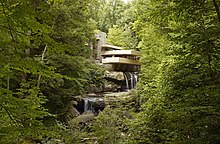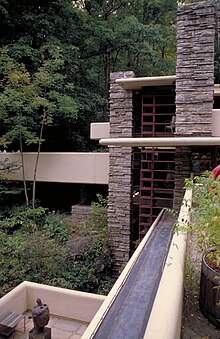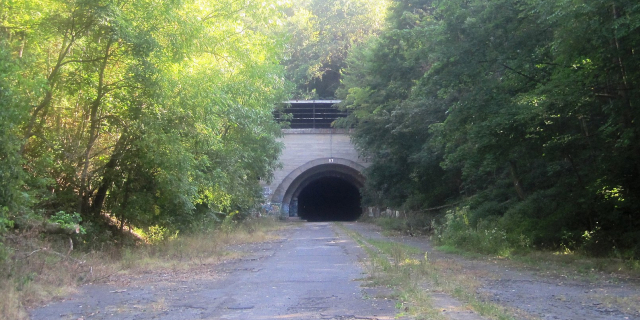Fallingwater
Fallingwater is a house designed by the architect Frank Lloyd Wright in 1935. Situated in the Mill Run section of Stewart township, in the Laurel Highlands of southwest Pennsylvania, about 70 miles (110 km) southeast of Pittsburgh in the United States, it is built partly over a waterfall on the Bear Run river. The house was designed to serve as a weekend retreat for Liliane and Edgar J. Kaufmann, the owner of Pittsburgh's Kaufmann's Department Store.
After its completion, Time called Fallingwater Wright's "most beautiful job" and it is listed among Smithsonian's "Life List of 28 Places to See Before You Die". The house was designated a National Historic Landmark on May 11, 1976. In 1991, members of the American Institute of Architects (AIA) named Fallingwater the "best all-time work of American architecture" and in 2007, the AIA ranked it 29th on its list of America's Favorite Architecture.
In 2019, the hou...Read more
Fallingwater is a house designed by the architect Frank Lloyd Wright in 1935. Situated in the Mill Run section of Stewart township, in the Laurel Highlands of southwest Pennsylvania, about 70 miles (110 km) southeast of Pittsburgh in the United States, it is built partly over a waterfall on the Bear Run river. The house was designed to serve as a weekend retreat for Liliane and Edgar J. Kaufmann, the owner of Pittsburgh's Kaufmann's Department Store.
After its completion, Time called Fallingwater Wright's "most beautiful job" and it is listed among Smithsonian's "Life List of 28 Places to See Before You Die". The house was designated a National Historic Landmark on May 11, 1976. In 1991, members of the American Institute of Architects (AIA) named Fallingwater the "best all-time work of American architecture" and in 2007, the AIA ranked it 29th on its list of America's Favorite Architecture.
In 2019, the house and seven other Wright constructions were inscribed as World Heritage Sites under the title, "The 20th-Century Architecture of Frank Lloyd Wright”.
 Fallingwater, as seen from Bear Run
Fallingwater, as seen from Bear RunAt age 67, Frank Lloyd Wright was given the opportunity to design and construct three buildings. With his three works of the late 1930s, (Fallingwater, the Johnson Wax Building in Racine, Wisconsin, and the Herbert Jacobs house in Madison, Wisconsin), Wright regained his prominence in the architectural community.[1]
The KaufmannsEdgar J. Kaufmann was a Pittsburgh businessman and president of Kaufmann's Department Store. Liliane Kaufmann, like her husband, was a keen outdoors person; she enjoyed both hiking and horseback riding. She had a strong aesthetic sensibility which is reflected in the house's design.[2]
Edgar and Liliane's only child, Edgar Kaufmann Jr., became the catalyst for his father's relationship with Frank Lloyd Wright.[2] In the summer of 1934, Kaufmann read Frank Lloyd Wright's An Autobiography (1932) and traveled to meet him at his home in Wisconsin in late September. Within three weeks, he began an apprenticeship at the Taliesin Fellowship, a communal architecture program established in 1932 by Wright and his wife, Olgivanna. It was during a visit with their son at Taliesin in November 1934 that Edgar and Liliane Kaufmann first met Wright.[2]
The Kaufmanns lived in La Tourelle, a French Norman estate in Fox Chapel designed in 1923 by Pittsburgh architect Benno Janssen. However, the family also owned a remote property outside Pittsburgh—a small cabin near a waterfall—which was used as a summer retreat. When these cabins deteriorated, Kaufmann contacted Wright.
On December 18, 1934, Wright visited Bear Run and asked for a survey of the area around the waterfall.[3] One was prepared by Fayette Engineering Company of Uniontown, Pennsylvania, including all the site's boulders, trees, and topography, and forwarded to Wright in March 1935.[4]
Construction The strong horizontal and vertical lines are a distinctive feature of Fallingwater
The strong horizontal and vertical lines are a distinctive feature of FallingwaterAs reported by Frank Lloyd Wright's apprentices at Taliesin, Kaufmann was in Milwaukee on September 22, nine months after their initial meeting, and called Wright at home early Sunday morning to surprise him with the news that he would be visiting him that day. Wright had told Kaufmann in earlier communications that he had been making progress on the plans but in actuality, he had not done anything. After breakfast, amid a group of very nervous apprentices, Wright calmly drew the plans in the two hours in which it took Kaufmann to drive to Taliesin.[5] Witnesses Edgar Tafel and Robert Mosher, Taliesin apprentices at the time, later stated that when Wright was designing the plans he spoke of how the spaces would be used, directly linking form to function.[6]
Wright designed the home above the waterfall: Kaufmann had expected it to be below the falls to afford a view of the cascades.[7][8] It has been said that he was initially very upset with this change.[3]
The Kaufmanns planned to entertain large groups so the house needed to be larger than the original plot allowed. They also requested separate bedrooms as well as a bedroom for their adult son and an additional guest room.[3] A cantilevered structure was used to address these requests.[3] The structural design for Fallingwater was undertaken by Wright in association with staff engineers Mendel Glickman and William Wesley Peters, who had been responsible for the columns in Wright's revolutionary design for the Johnson Wax Headquarters.
Preliminary plans were issued to Kaufmann for approval on October 15, 1935,[9] after which Wright made an additional visit to the site to generate a cost estimate for the job. In December 1935, an old rock quarry was reopened to the west of the site to provide the stones needed for the house's walls. Wright visited only periodically during construction, assigning his apprentice Robert Mosher as his permanent on-site representative.[9] The final drawings were issued by Wright in March 1936 with work beginning on the bridge and main house in April.
The construction was plagued by conflicts between Wright, Kaufmann, and the contractor. Uncomfortable with what he saw as Wright's insufficient experience using reinforced concrete, Kaufmann had the architect's daring cantilever design reviewed by a firm of consulting engineers. Upon receiving their report, Wright took offense, immediately requesting that Kaufmann return his drawings and indicating that he was withdrawing from the project. Kaufmann relented to Wright's gambit and the engineer's report was subsequently buried within a stone wall of the house.[9]
For the cantilevered floors, Wright and his team used upside-down T-shaped beams integrated into a monolithic concrete slab which formed both the ceiling of the space below and provided resistance against compression. The contractor, Walter Hall, also an engineer, produced independent computations and argued for increasing the reinforcing steel in the first floor's slab—Wright refused the suggestion. There was speculation over the years that the contractor quietly doubled the amount of reinforcement[10] versus Kaufmann's consulting engineers doubling the amount of steel specified by Wright.[9] During the process of restoration begun in 1995, it was confirmed that additional concrete reinforcement had been added.
In addition, the contractor did not build in a slight upward incline in the formwork for the cantilever to compensate for its settling and deflection. Once the formwork was removed, the cantilever developed a noticeable sag. Upon learning of the unapproved steel addition, Wright recalled Mosher.[11] With Kaufmann's approval, the consulting engineers had a supporting wall installed under the main supporting beam for the west terrace. When Wright discovered it on a site visit, he had Mosher discreetly remove the top course of stones. When Kaufmann later confessed to what had been done, Wright showed him what Mosher had done and pointed out that the cantilever had held up for the past month under test loads without the wall's support.[12]
The main house was completed in 1938 and the guest house was completed the following year.[13]
CostThe original estimated cost for building Fallingwater was $35,000. The final cost for the home and guest house was $155,000,[14][15][16] which included $75,000 for the house; $22,000 for finishings and furnishings; $50,000 for the guest house, garage and servants' quarters; and an $8,000 architect's fee. From 1938 through 1941, more than $22,000 was spent on additional details and for changes in the hardware and lighting.[17]
The total cost of $155,000, adjusted for inflation, is equivalent to about $3.3 million in 2023. The cost of the house's restoration in 2001 was estimated to be $11.5 million (approximately $19 million in 2023).[18]
UsageFallingwater was the Kaufmann family's weekend home from 1937 until 1963, when Edgar Kaufmann Jr. donated the property to the Western Pennsylvania Conservancy.[15] The family retreated to Fallingwater on weekends to escape the heat and smoke of industrial Pittsburgh. Liliane enjoyed swimming in the nude and collecting modern art, especially the works of Diego Rivera, who was a guest at the country house.[19]
[Wright] understood that people were creatures of nature, hence an architecture which conformed to nature would conform to what was basic in people. For example, although all of Falling Water [sic] is opened by broad bands of windows, people inside are sheltered as in a deep cave, secure in the sense of the hill behind them.
The "Fallingwater" name originated with Wright in late 1937, when he wrote the text that accompanied a feature article on Wright's career in the January 1938 Architectural Forum. Until that time it had been referred to on Wright's drawings and in correspondence as the E.J. Kaufmann Residence or E.J. Kaufmann House, the names used in publications covering the house's construction. The new name immediately became popular, and was amplified by a 1938 exhibition at the Museum of Modern Art and in Henry Luce's popular magazines Time and Life. The name was apparently disliked by E.J. and Liliane Kaufmann, who did not use it.[21]


































Add new comment